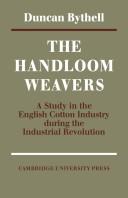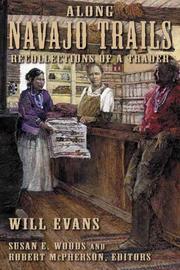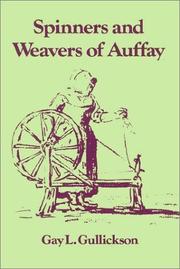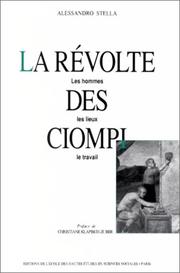| Listing 1 - 10 of 15 | << page >> |
Sort by
|

ISBN: 0511895992 0521075807 052107150X Year: 1969 Publisher: Cambridge : Cambridge University Press,
Abstract | Keywords | Export | Availability | Bookmark
 Loading...
Loading...Choose an application
- Reference Manager
- EndNote
- RefWorks (Direct export to RefWorks)
'No other group of workers in the history of the English working-class has received more sympathy and less scholarly attention than the handloom weavers of the Lancashire cotton industry during the Industrial Revolution.' Mr Bythell's is a detailed study of this important group. His aim is to examine the transition from the domestic system to the factory system in cotton weaving in the first half of the nineteenth century. He provides detailed information on the geographical distribution of handloom weaving, the size and structure of the labour force, the varying history of employment, wages and standard of life, the efforts made by the weavers to alleviate their distress through industrial and political action, and their final displacement and disappearance. The results of his research enable Mr Bythell to challenge several of the generally accepted views about the weavers.
Weavers --- Industrial revolution --- Artisans --- Arts and Humanities --- History
Book
Year: 1972 Publisher: London : Routledge and Kegan Paul,
Abstract | Keywords | Export | Availability | Bookmark
 Loading...
Loading...Choose an application
- Reference Manager
- EndNote
- RefWorks (Direct export to RefWorks)
Tisserands artisans --- Londres (grande-bretagne) --- Weavers'company --- Textiles et tissus --- Grande-bretagne --- Industrie et commerce

ISBN: 0874216060 9786613275240 1283275244 0874215234 9780874215236 9781283275248 0874216052 9780874216059 9780874216066 Year: 2005 Publisher: Utah State University, University Libraries
Abstract | Keywords | Export | Availability | Bookmark
 Loading...
Loading...Choose an application
- Reference Manager
- EndNote
- RefWorks (Direct export to RefWorks)
Will Evans was the proprietor of the Shiprock Trading Company in early 20th century New Mexico. Probably more than most of his fellow traders, he had a strong interest in Navajo culture. He published in the local newspaper and other periodicals and compiled many of his pieces into a book manuscript. His subjects were Navajos he knew and traded with, their stories of historic events such as the Long Walk, and descriptions of their culture as he, an outsider without academic training, understood it.
History. --- Indian traders. --- Indian traders - New Mexico - Shiprock Region - History. --- Navajo Indians - New Mexico - Shiprock Region - History. --- Navajo Indians - New Mexico - Shiprock Region - Social life and customs. --- Navajo Indians. --- Navajo weavers. --- Navajo weavers - New Mexico - Shiprock Region - History. --- Shiprock Region (N.M.) - History. --- Shiprock Region (N.M.) - Social life and customs. --- Social life and customs. --- Trading posts. --- Trading posts - New Mexico - Shiprock Region - History. --- Navajo Indians --- Navajo weavers --- Trading posts --- Indian traders --- Gender & Ethnic Studies --- Social Sciences --- Ethnic & Race Studies --- History --- Social life and customs --- Shiprock Region (N.M.) --- Traders, Indian --- Posts, Trading --- Weavers, Navajo --- Diné Indians (Navajo) --- Navaho Indians --- Merchants --- Barter --- Weavers --- Athapascan Indians --- Indians of North America
Book
ISSN: 0001415X ISBN: 9782870440032 2870440030 Year: 2010 Volume: [18] Publisher: Bruxelles Palais des Académies
Abstract | Keywords | Export | Availability | Bookmark
 Loading...
Loading...Choose an application
- Reference Manager
- EndNote
- RefWorks (Direct export to RefWorks)
French literature --- Chavatte, P. --- Lille --- --Histoire économique et sociale --- --Vie quotidienne --- --Chavatte, Pierre-Ignace, --- mémorial --- --944.03 --- History France (1589 - 1789) --- 944.03 --- Weavers --- Tisserands --- Economic history. --- Social conditions. --- Weavers. --- vie quotidienne --- 1693 --- Chavatte, Pierre Ignace, --- 1600-1715. --- Lille (France) --- France --- France. --- Lille (Nord) --- Social conditions --- History --- Economic conditions --- Conditions sociales --- Conditions économiques --- Histoire --- --Weavers --- Histoire économique et sociale --- Vie quotidienne --- Chavatte, Pierre-Ignace, 1657-1693 --- Journaux intimes --- 17e siècle --- Récits personnels
Book
ISBN: 0333212304 0333212312 9780333212318 9780333212301 Year: 1982 Publisher: London: MacMillan,
Abstract | Keywords | Export | Availability | Bookmark
 Loading...
Loading...Choose an application
- Reference Manager
- EndNote
- RefWorks (Direct export to RefWorks)
Multi
ISBN: 9781108774215 1108774210 110880778X 9781108489201 9781108733625 1108800998 1108489206 Year: 2024 Publisher: Cambridge Cambridge University Press
Abstract | Keywords | Export | Availability | Bookmark
 Loading...
Loading...Choose an application
- Reference Manager
- EndNote
- RefWorks (Direct export to RefWorks)
Textile industry --- Weavers --- Flemings --- Social integration --- Economic development --- History --- England --- Emigration and immigration --- History of the United Kingdom and Ireland --- anno 1300-1399
Book
ISBN: 180543277X 1837650136 Year: 2024 Publisher: Woodbridge, England : The Boydell Press,
Abstract | Keywords | Export | Availability | Bookmark
 Loading...
Loading...Choose an application
- Reference Manager
- EndNote
- RefWorks (Direct export to RefWorks)
An examination of the uses, meanings, and social impact of Viking Age textiles.
Textile fabrics, Viking --- Women weavers --- Textile fabrics --- Women, Viking --- Archaeological Textiles. --- Fleece Processing. --- Greenland. --- Iceland. --- King Harald. --- Norse. --- Preservation of Textiles. --- Reproduction Fabrics. --- Vararfeldir. --- Wool. --- Íslendingasögur. --- History.

ISBN: 0521322804 0521522498 051152885X 0511871139 Year: 1986 Publisher: Cambridge : Cambridge University Press,
Abstract | Keywords | Export | Availability | Bookmark
 Loading...
Loading...Choose an application
- Reference Manager
- EndNote
- RefWorks (Direct export to RefWorks)
The cottage industry of France enjoyed enormous growth from the mid-eighteenth to the mid-nineteenth century. Through an intensive analysis of the social and economic impact of the expansion of this female-dominated industry, Gay Gullickson broadens our understanding of the variety and complexity of proto-industrial regions and of the proto-industrial processes. Focusing on the village of Auffay, located in the pays de Caux, a thriving agricultural region, Gullickson recreates the experiences of the women and men who spun and wove for the urban putting-out merchants. Social analysis of local memoirs, government reports, notarial and judicial records, and village cahiers de doléances, enables Gullickson to offer a more nuanced and accurate view of the causes and consequences of the expansion of the cottage textile industry in the pre-factory era. Her 1987 study is further enhanced by a quantitative analysis based primarily on the reconstitution of the families of the 727 couples who married in Auffay between 1750 and 1850.
Occupations --- -Rural industries --- -Sexual division of labor --- -Weavers --- -Artisans --- Division of labor by sex --- Division of labor --- Sex role --- Sex discrimination in employment --- Industrialization, Rural --- Rural industrialization --- Rural industry --- Industries --- Career patterns --- Careers --- Jobs --- Trades --- Handicraft --- Vocational guidance --- Work --- History --- Rural industries --- Sexual division of labor --- Weavers --- History. --- -History --- Artisans --- Arts and Humanities

ISBN: 2713210046 9782713210044 Year: 1993 Volume: 57 Publisher: Paris: École des hautes études en sciences sociales,
Abstract | Keywords | Export | Availability | Bookmark
 Loading...
Loading...Choose an application
- Reference Manager
- EndNote
- RefWorks (Direct export to RefWorks)
Ciompi [Opstand van de ], 1378 --- Ciompi [Revolt of the ], 1378 --- Ciompi [Révolte des ], 1378 --- Ciompi, Revolt of the, 1378 --- Weavers --- Riots --- Florence (Italie) --- Tisserands --- Emeutes --- Histoire --- Florence (Italy) --- History --- Ciompi, Revolt of the, 1378. --- -Weavers --- -Artisans --- Civil disorders --- Assembly, Right of --- Offenses against public safety --- Political violence --- Crowds --- Demonstrations --- Mobs --- Street fighting (Military science) --- Revolt of the Ciompi, 1378 --- Tumulto dei Ciompi, 1378 --- -History --- -Ciompi, Revolt of the, 1378. --- -Florence (Italy) --- -Ciompi, Revolt of the, 1378 --- Labor movement --- Artisans --- Weavers - Italy - Florence. --- Riots - Italy - Florence. --- FLORENCE (ITALIE) --- MOYEN AGE --- TRAVAIL ET TRAVAILLEURS --- CONDITIONS SOCIALES --- 14E-16E SIECLES --- 10E-15E SIECLE --- HISTOIRE
Book
ISBN: 968120865X 607628840X Year: 1998 Publisher: México, D.F. El Colegio de México
Abstract | Keywords | Export | Availability | Bookmark
 Loading...
Loading...Choose an application
- Reference Manager
- EndNote
- RefWorks (Direct export to RefWorks)
La obra de Manuel Miño constituye un interesante intento de explicación del funcionamiento de los diversos sectores de la actividad textil en la Nueva España, en el periodo comprendido entre 1700 y 1810. La hipótesis central de su investigación parte de la consideración de que la organización productiva del obraje, tal y como se había planteado en siglos anteriores, no era posible en el siglo XVIII.
Microeconomics --- Economic production --- anno 1700-1799 --- Mexico --- Tisserands --- Textiles et tissus --- Histoire --- Industrie et commerce --- Textile industry --- Weavers --- History --- Artisans --- Textile industry and fabrics --- Textiles industry --- Manufacturing industries --- Apparel, garment & textile industries --- textielnijverheid
| Listing 1 - 10 of 15 | << page >> |
Sort by
|

 Search
Search Feedback
Feedback About UniCat
About UniCat  Help
Help News
News